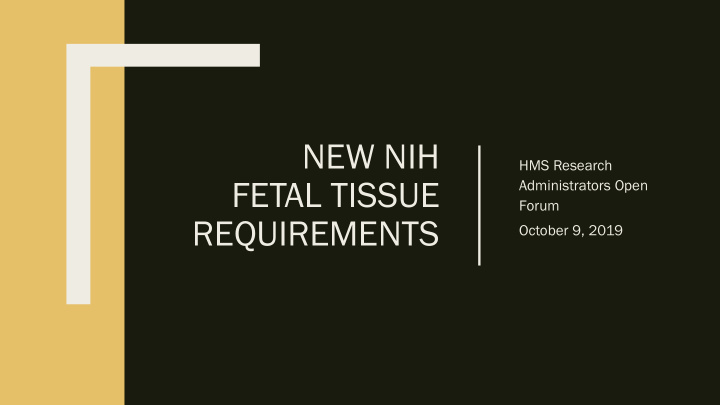



NEW NIH HMS Research FETAL TISSUE Administrators Open Forum REQUIREMENTS October 9, 2019
Broader Definition of Human Fetal Tissue (HFT) The new NIH Requirements APPL PPLY to HFT obtained from elective a abortion ons. HFT is The new NIH Requirements DO N NOT OT apply to: defined to include: • human fetal pri primary or or se secondary c cell • Materials NOT OT derived from an elective culture res, whether derived by the investigator abortion or obtained from a vendor. • embryonic stem cells or embryonic cell lines, • animal m models s incorporating HFT. or • derivative products such as pr protein or or • already-established (as of June 5, 2019) nucl cleic a c acid extract acts. human fetal cell lines • any human extra-embryon onic c cells s and t tissu ssue, such as umbilical cord tissue, cord blood, placenta, amniotic fluid, and chorionic villi
What is Required? ■ Scientists submitting grants that involve HFT will be subject to review by a federal ethics panel and required to: – Provide a justification for the use of HFT and explain why other tissue types cannot be used, – Demonstrate that HFT donations were made through a more robust informed consent process than previously required, – Explain where the researchers plan to get the HFT, and – Provide written assurances that the original donation of HFT complied with new NIH requirements
Who will be impacted? ■ PIs submitting competing grant applications involving the use of HFT for due dates on or after September 25, 2019 ■ PIs that add the use of HFT to on-going grants ■ NIH currently funds roughly 200 projects that use fetal tissue. ■ The expanded definition may impact PIs who were not previously considered to be conducting HFT research—e.g. – PIs using humanized mice that they receive from a vendor – PIs using umbilical cord tissue, cord blood, placenta, or amniotic fluid in their research – PIs using derivative products such as protein or nucleic acid extracts
Delays in funding or potential non-funding of projects within a fundable score range Challenges in meeting page limitations Potential Challenges in providing required assurances (PI and and Institution) Impacts Challenges in demonstrating when the requirements do not apply Addition of research involving HFT is considered a change in scope, requiring a competing revision application and compliance with new requirements, even for currently funded projects.
QUESTIONS?
Recommend
More recommend